Health Articles
Find out more about your health here from our health professionals!
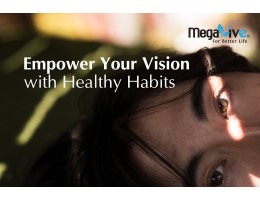
See the World Clearly - Empower Your Vision with Healthy Habits
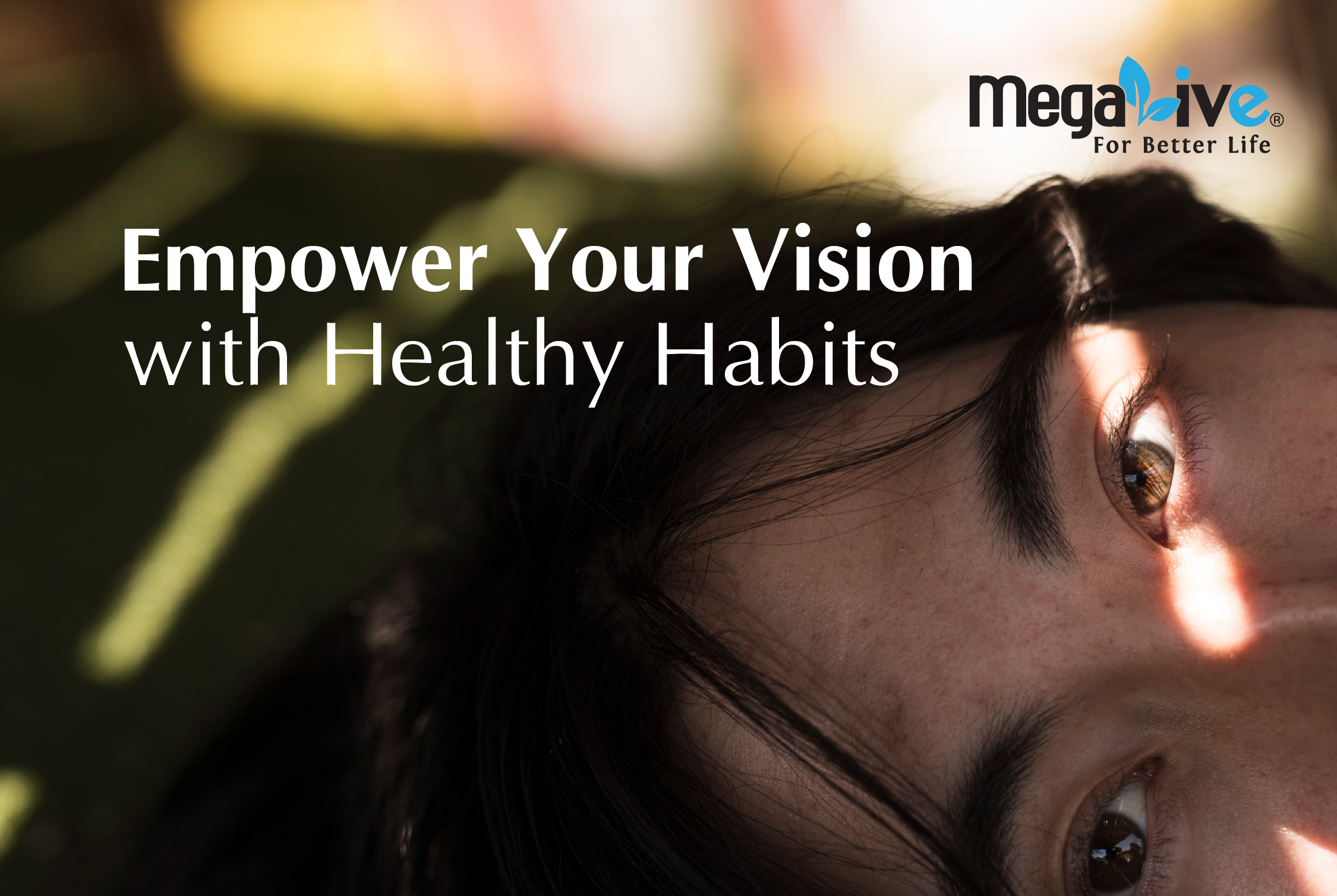
Our eyes are one of the most vital and delicate parts of our body, yet they are often overlooked when it comes to self-care. With the increasing use of digital screens, environmental stress, and the natural aging process, maintaining eye health is more important than ever. Here are some essential tips to help you protect and improve your vision for years to come.
1. Follow the 20-20-20 Rule
If you spend long hours in front of a screen, you may experience eye strain, dry eyes, or blurry vision. To reduce digital eye strain, follow the 20-20-20 rule:
Every 20 minutes, take a 20-second break and look at something 20 feet away. This helps relax the eye muscles and reduce fatigue [1].
2. Eat a Balanced Diet for Healthy Eyes
The saying "you are what you eat" rings true when it comes to eye health. Nutrient-rich foods provide the necessary vitamins and minerals to support vision. Some key nutrients to include in your diet are:
-
Lutein and Zeaxanthin: These antioxidants help protect the retina from harmful light and oxidative stress. Foods like spinach, kale, and other leafy greens are rich in these nutrients [2].
-
Vitamin A: Essential for good vision, especially in low light. Sources of vitamin A include carrots, sweet potatoes, liver and fish [3].
3. Protect Your Eyes from UV Rays
Global atmospheric changes, such as ozone depletion in the stratosphere, have led to increased ultraviolet (UV) radiation on Earth. This heightened UV exposure can adversely affect human health and has been linked to serious eye conditions, including cataracts and retinal degeneration [4].
UV rays may cause damage through the formation of free radicals, which can lead to protein modification and lipid peroxidation in eye tissues.
To reduce the risk, always wear suitable UV-protective glasses when outdoors. Wraparound sunglasses that block 100% of UVA and UVB rays provide the best protection.
4. Consider Eye Supplements
If you are concerned about your eye health or have a family history of eye diseases, consider taking eye supplements. Strong recommend for products are rich in ingredients like Lutein and Zeaxanthin, which are scientifically proven to support healthy vision and reduce the risk of macular degeneration and other age-related eye problems.
5. Schedule Regular Eye Check-Ups
Regular eye exams are essential for detecting eye conditions early, even before symptoms appear. These exams not only assess vision clarity but also check for diseases such as retinal detachment, glaucoma, development of cataracts, and macular degeneration. Early detection through routine check-ups can prevent vision loss and ensure timely treatment to maintain healthy eyes [6].
Conclusion
Your eye health deserves as much attention as any other part of your body. By maintaining a balanced diet, protecting your eyes from UV rays, following healthy screen habits, and scheduling regular eye exams, you can keep your eyes in top condition for many years. Remember, small lifestyle changes can make a huge difference in your overall vision health
References:
1. Nall, R. (2024). Does the 20-20-20 rule prevent eye strain? Medical News Today. https://www.medicalnewstoday.com/articles/321536
2. Roberts, J. E., & Dennison, J. (2015). The photobiology of lutein and zeaxanthin in the eye. Journal of Ophthalmology, 2015, Article 687173. https://pmc.ncbi.nlm.nih.gov/articles/PMC4698938/
3. Sulaiman, S. A., & Tan, S. H. (2022). Visual field decline and restoration following vitamin A therapy for nutritional vitamin A deficiency. Journal of Clinical and Translational Science, 6(1), e23. https://www.sciencedirect.com/science/article/pii/S2451993622002171
4. Van Kuijk, F. J. (1991). Effects of ultraviolet light on the eye: Role of protective glasses. Environmental Health Perspectives, 96, 177–184. https://www.jstor.org/stable/3431229
5. Zhou J, Wang F, Zhou S, et al. (2020). Effect of lutein, zeaxanthin, blackcurrant, chrysanthemum, and goji berry on visual function and eye fatigue: A randomized, double-blind, placebo-controlled trial. Am J Clin Nutr. https://www.sciencedirect.com/science/article/pii/S0002916522008036
6. Patel, H. H. (2019, February 26). Importance of regular eye checks and the check-up procedure. News-Medical. https://www.news-medical.net/health/Importance-of-Regular-Eye-Checks-Procedure.aspx
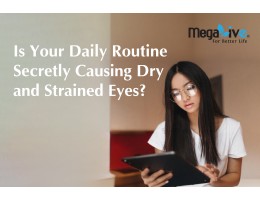
Is Your Daily Routine Secretly Causing Dry and Strained Eyes?

In our modern world, many people suffer from dry and strained eyes, especially with the rise of digital device use and changing environmental factors. These common eye problems can cause discomfort, affect productivity, and reduce quality of life if left unaddressed. Understanding their causes and how to prevent or treat them is essential for maintaining good eye health.
What Causes Eye Strain?
Eye strain happens when your eyes get tired from intense use. It commonly occurs during activities like reading, working on a computer, or focusing on detailed work for long periods without breaks.
Common causes of eye strain include:
1. Prolonged Screen Time (Digital Eye Strain)
1.1 Reduced Blinking: When we focus on digital screens, we tend to blink less, leading to dry eyes and eye strain.
1.2 Poor Screen Resolution and Contrast: Low-quality screens with poor contrast or improper brightness can strain the eyes.
1.3 Glare: Reflections from screens can cause discomfort and eye strain.
1.4 Improper Viewing Distance: Being too close to a screen or having improper screen positioning can exacerbate eye strain[1].
1.5 Oxidative stress:Oxidative stress remains a significant concern, particularly for vulnerable populations such as the elderly or individuals with preexisting retinal conditions. Cumulative blue light exposure from both digital devices and sunlight may contribute to retinal cell damage and potentially increase the long term risk of age related macular degeneration (AMD)[6].
2. Intense Focus Activities
2.1 Reading: Reading for extended periods, especially without breaks, can fatigue the eye muscles.
2.2 Driving: Driving long distances or engaging in other activities that require continuous focus can cause eye strain.
2.3 Detailed Work:Tasks involving close-up work, such as sewing or crafting, can strain the eyes. [2].
3. Environmental Factors
3.1 Bright Light or Glare: Excessive exposure to bright light or glare can tire the eyes [3].
3.2 Dry Air: Dry or polluted environments and places with fans and heating and cooling units may irritate or dry out eyes, leading to eyestrain[4].
Conclusion
Strained eyes are common in today’s digital age but don’t have to interfere with your daily life. By understanding their causes and adopting healthy habits in our upcoming health articles, you can protect your eyes, reduce discomfort, and maintain clear, comfortable vision.
References:
-
Kaur, K., Gurnani, B., Nayak, S., Deori, N., Kaur, S., Jethani, J., Singh, D., Agarkar, S., Hussaindeen, J. R., Sukhija, J., & Mishra, D. (2022). Digital eye strain—A comprehensive review. Ophthalmology and Therapy. https://pmc.ncbi.nlm.nih.gov/articles/PMC9434525/
-
American Academy of Ophthalmology. (n.d.). Computers, digital devices, and eye strain. Retrieved May 23, 2025. https://www.aao.org/eye-health/tips-prevention/computer-usage
-
BenQ. (n.d.). Protective peepers: The best eye-caring desk lamps for comfortable computing and study. BenQ. Retrieved May 23, 2025, from https://www.benq.com/en-my/knowledge-center/knowledge/eye-caring-desk-lamp-for-computer-and-studying.html
-
Silver, N. (2024, August 29). Eyestrain: Causes, tips for prevention, and treatments. Healthline. Retrieved May 23, 2025, https://www.healthline.com/health/eye-health/eye-strain#eye-drops
-
Chakravarthy, H., Georgyev, V., Wagen, C., Hosseini, A., & Matsubara, J. (2024). Blue light-induced phototoxicity in retinal cells: Implications in age-related macular degeneration. Frontiers in Aging Neuroscience, https://pmc.ncbi.nlm.nih.gov/articles/PMC11685196/
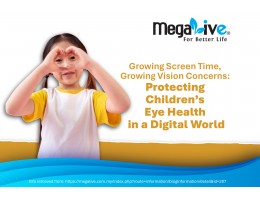
Growing Screen Time, Growing Vision Concerns: Protecting Children’s Eye Health in a Digital World
With digital devices becoming central to both learning and play, children are spending more time than ever in front of screens. Unfortunately, this rise in screen time has led to an increase in vision issues among children worldwide, including in Malaysia.
Studies show that globally, nearly 30% of school-aged children experience myopia (nearsightedness), a statistic that is climbing each year. In Malaysia, a recent survey revealed that over 20% of children have some form of vision impairment. This rise is linked to prolonged screen time, especially during the COVID-19 pandemic, when virtual learning became essential.
Several factors contribute to this trend. The blue light emitted from screens can cause eye strain and disrupt sleep, while focusing on close-up screens for extended periods may lead to digital eye strain or even contribute to the development of myopia. Limited outdoor time is another factor; natural sunlight is known to support healthy vision development, and children spending more time indoors tend to have higher rates of myopia.

Parents and caregivers can help protect children’s eyes by encouraging regular breaks with the 20-20-20 rule: every 20 minutes, look at something 20 feet away for at least 20 seconds. Prioritizing outdoor play also allows children’s eyes to relax from close-up screen focus. Practicing good screen habits—such as setting appropriate brightness, avoiding screens in dark environments, and keeping devices at a safe distance from the eyes—can also reduce strain.
In addition to these habits, eye health supplements and foods that are rich with nutrients thacan support children’s vision are particularly beneficial, such as lutein and zeaxanthin. Lutein and zeaxanthin act as natural filters against blue light, helping to protect the retina and maintain visual sharpness. Vitamins C and E are also powerful antioxidants that shield eye tissues from oxidative stress, promoting long-term eye health.
As digital devices become essential in daily life, it’s crucial to balance their benefits with proactive eye care. By practicing good screen habits and considering dietary support, we can help children maintain bright, clear eyesight in our fast-changing, screen-centric world.
References
-
World Health Organization (WHO): World report on vision. Geneva: WHO, 2019. This report discusses global vision health trends and the impact of screen time on vision issues, including myopia in children.
-
American Optometric Association: Digital Eye Strain and Myopia Management in Children. This provides information on digital eye strain, myopia, and best practices to mitigate eye strain for children.
-
Ministry of Health Malaysia: National Eye Survey (NES) Malaysia. This survey provides statistics on visual impairment in Malaysia, including data on children’s eye health.
-
American Academy of Ophthalmology: Recommendations on children’s screen time and its potential impact on eye health.
-
Research on Eye Supplements: Various studies on lutein, zeaxanthin, and other antioxidants for eye health, such as "Lutein and Zeaxanthin Isomers in Eye Health and Disease" (Nutrients, 2020), which details their benefits for retinal protection against blue light.
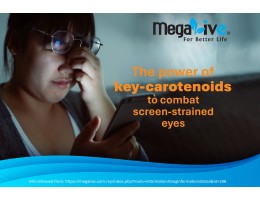
The Power of Key Carotenoids for Screen-Strained Eyes
Our eyes face unique challenges in today’s screen-centric lifestyle. Between digital devices, indoor lighting, and environmental pollutants, our eyes are working overtime. Fortunately, natural ingredients can help protect our eyes from these modern-day stressors, keeping our vision sharp and comfortable.
-
Bilberry Extract: Known for enhancing blood circulation to the eyes, bilberry extract is especially helpful for those who experience eye strain from screens. Its antioxidant properties protect against oxidative damage, a common result of prolonged screen exposure, supporting clear vision and comfort in low-light settings.
-
Lutein and Zeaxanthin: These powerful carotenoids are nature’s blue light filter. Abundant in marigold flowers, they absorb and neutralize high-energy blue light, reducing digital eye strain and improving visual sharpness for screen users. Lutein and zeaxanthin are especially crucial for anyone spending long hours on digital devices.
-
Beta-Carotene: As a precursor to vitamin A, beta-carotene is essential for healthy vision, particularly in low-light conditions. For those who experience screen-induced eye fatigue, beta-carotene’s role in supporting eye adaptability to varying light levels is invaluable.
-
Grape Seed Extract: Packed with antioxidants known as proanthocyanidins, grape seed extract promotes healthy blood vessels, ensuring the eyes receive a steady flow of oxygen and nutrients. This circulation boost is particularly beneficial for those experiencing screen-induced eye strain and fatigue.
By integrating these eye-friendly nutrients into your routine, you can help combat screen strain and keep your eyes feeling refreshed throughout the day.
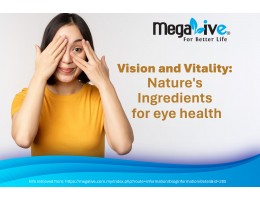
Vision and Vitality: Nature’s Ingredients for Eye Health
Our eyes are constantly exposed to screens, sunlight, and environmental stressors. Fortunately, specific natural ingredients are celebrated for their role in supporting and maintaining eye health. Here’s a look at how these powerful components work together to protect our vision and overall wellness.
1. Bilberry and Grape Seed Extracts: Known for their rich antioxidants, bilberry and grape seed extracts offer natural protection against oxidative damage. This helps reduce strain on the eyes, while also supporting healthy blood vessels, which are crucial for maintaining clear vision.
2. Maqui Berry Extract: Maqui berries are a nutrient-dense powerhouse with high anthocyanin content, which promotes eye comfort and reduces symptoms of dry eyes. Their anti-inflammatory properties also contribute to long-term eye health, especially for those frequently exposed to screens.
3. Lutein & Zeaxanthin: Lutein and zeaxanthin are types of carotenoids, found abundantly in marigold flower extract. They act as natural filter against blue light. Studies noted that, optimized Lutein & Zeaxanthin (Lutemax ® 2020), a patented blend delivering 5:1 ratio of lutein to zeaxanthin, offers optimal protection against blue light from screens and environmental stress as it guards retina and supporting visual sharpness. These also play a key role in reducing the risk of age-related vision concern in the long term.

4. Algae Oil Powder: A natural source of omega-3 fatty acids, algae oil powder provides essential nutrients that help maintain the moisture and health of the eye’s surface. Omega-3s are also known to support cognitive function and overall cellular health, making it a valuable addition to daily wellness.
Together, these ingredients offer a comprehensive approach to eye care—promoting comfort, protecting vision, and supporting vitality. Embrace nature’s finest for eye health and let your vision shine bright!
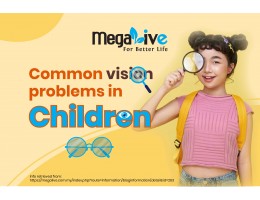
Common Vision Problems in Children
Children’s vision helps them to experience and explore the world around them. It is a crucial part of their development. If children have an uncorrected vision problem, it can affect their ability to learn and reach their highest potential.
Vision does not fully develop when a baby is born. Only when children are 18 months to 4 years old do vision problems in kids tend to emerge, and they are hard to detect because children are not aware that their vision is compromised because they have been seeing it that way and that is all they have ever known.
Here are some common vision problems in children:
- Amblyopia (lazy eye)
This condition occurs when vision in one eye is reduced due to a communication error between the brain and the affected eyes.
The visual impairment from amblyopia can persist during adulthood if treatment has not been previously offered. This is because the brain has learned to ‘ignore’ or ‘suppress’ the images coming from the poorer eye. These deficits derive from the visual areas of the brain.
Treatment involves normalising the poorer eye (often with glasses and/or eye patching) and re-training the eyes and the brain to work in a normal way (often with orthoptic eye exercises, called vision therapy). The treatments are most successful for young children, but adults can also benefit from the vision therapy.
- Myopia (Shortsightedness)
Occurs when the eyes are unable to focus clearly on objects that are far away. The image falls ‘in front’ of the retina when one looks at a distant object. This does not usually affect close-up vision except in high myopia.
- Hyperopia (Longsightedness)
Occurs when the eyes are unable to focus clearly on objects that are close-up. It can also affect far-distance vision in some cases. The image falls ‘at the back’ of the retina when one looks at a near object, and it often makes it difficult for the eyes to focus.
- Astigmatism
This condition occurs when the cornea has an irregular shape. It often occurs together with myopia or hyperopia, and it can result in blurred vision. Even without myopia or hyperopia, the astigmatic eye will not be able to focus sharply, and one might complain about glare or visual discomfort, particularly in poor lighting. It is often associated with headaches, dizziness, and eyestrain.
- Strabismus (Crossed eyes)
Occurs when the two eyes turn in different directions. It can occur in a child or an adult. When one eye is aligned well, the other may turn in or out, up or down. This may be noticeable all the time, or it may be intermittent. It may be present soon after birth or appear at a later age. It may be due to a weak eye muscle or a nerve palsy. Some people get their eyes surgically realigned, while others may get ‘orthoptic’ eye exercises. The latter is also called vision therapy, and it often involves the use of prisms and a range of equipment to retrain the visual system.
Most of the time, vision problems are not obvious, making them hard to catch. The best way to catch the issues early is through vision screenings. Warning signs may include:
- Eye rubbing
- Tearing
- Swelling
- Redness
- Pus
- Crust
- Sensitivity to light
- Bulging or jiggly eyes
- Droopy eyelids
- White, yellow, or grey-white material in the pupil
If you notice any of these, or your child’s eyes are changing in any way, or you simply worry about their vision, do not wait longer; get that first vision test. It is always safe and better to catch when things are still in the early phase rather than the later phase.
References
- Centers for Disease Control and Prevention. Keep an Eye on Your Child’s Vision. https://www.cdc.gov/visionhealth/resources/features/vision-health-children.html
- IGARD. Common Eye and Vision Problems in Children. https://www.igard.com.sg/services/children/common-eye-and-vision-problems-in-children/
- WebMD. Signs of Vision Problems in Young Kids. https://www.webmd.com/eye-health/features/child-eye-and-vision-problems
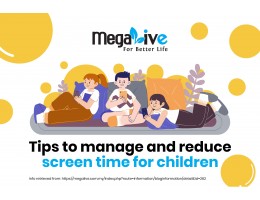
Tips to Manage and Reduce Screen Time for Children
Living in today's digital world, the ubiquity of screens and gadgets is unavoidable. Individuals of all ages rely on screens for communication and daily tasks. However, excessive screen time, particularly for children, can have detrimental effects. Studies suggest that prolonged screen exposure can lead to behavioral issues, such as a lack of focus, and contribute to health problems, including obesity.

The American Academy of Pediatrics recommends specific screen time limits:
- No screen time for children under 2
- One hour per day for children aged 2 to 12
- Two hours per day for teenagers and adults
For teenagers, research indicates a correlation between excessive screen time and negative outcomes such as anxiety, depression, and reduced attention span.
To mitigate the risks associated with too much screen time, consider implementing the following tips for both children and families in general:
- Open Communication with Your Family: Explain to your children the downsides of excessive screen time from an early age. Demonstrate alternative activities, such as playing board games, solving puzzles, coloring, painting, or developing new skills like riding a bike. For toddlers, model "pretend play" with toys, engaging in activities like running a restaurant or playing teacher and student. Older kids can explore outdoor activities or construct items, such as building with Lego.
- Lead by Example: Parents should serve as positive role models by limiting their own screen time. Children often emulate their parents' behavior more than their words.
- Establish Screen Time Limits: Enforce a household rule limiting screen time to a maximum of two hours per day. Consistency is key in maintaining these limits.
- Transform Mealtime into Family Time: Turn off the TV during family meals to foster connection. Prohibit the use of phones during this time. Research indicates that families who share meals tend to consume more nutritious food, making prioritizing family mealtime crucial.
- Avoid Using Screen Time as a Reward or Punishment: To foster a healthy relationship with screens, refrain from using screen time as a reward for good behavior. This practice can lead children to perceive screens as a "reward" for compliance, potentially reinforcing undesirable habits.
By implementing these strategies, parents can actively contribute to reducing screen time and promoting a healthier, more balanced lifestyle for their children and the entire family.
References
- National Health Institute (NIH). National Heart, Lung, and Blood Institute. Tips to reduce screen time. https://www.nhlbi.nih.gov/health/educational/wecan/reduce-screen-time/tips-to-reduce-screen-time.htm
- Mayo Clinic Health System. 6 Tips to reduce children’s screen time. https://www.mayoclinichealthsystem.org/hometown-health/speaking-of-health/6-tips-to-reduce-childrens-screen-time
-01-260x200.jpg)
What is age-related macular degeneration (AMD)?
Age-related macular degeneration (AMD) is a common condition that affects people over the age of 50. It is the leading cause of vision loss in older people. Individuals with AMD are not completely blind, but they are losing their central vision, making it difficult for them to see faces, read, drive, or do close-up work around the house such as cooking or fixing things. Individuals suffering from AMD are unable to see fine details, whether they are looking at something close or far away.
AMD progresses slowly in some people and quickly in others. AMD is a type of eye disease that causes blurring of the central vision of the eyes due to damage to the macula. The macula is a part of the retina that controls sharp, straight, and ahead vision.
Types of AMD
There are two types of AMD:
Dry AMD
The most common type of AMD, accounting for approximately 80% of all AMD. Dry AMD occurs when parts of the macula thin with age and tiny clumps of protein known as drusen form.
Wet AMD
A less common type of late AMD known as advance neovascular AMD causes faster vision loss. Wet AMD can develop at any stage of dry AMD, but it is always the late stage of AMD. It occurs when abnormal blood vessels develop in the back of the eye, causing damage to the macula. The good news is that there are treatment options for wet AMD.
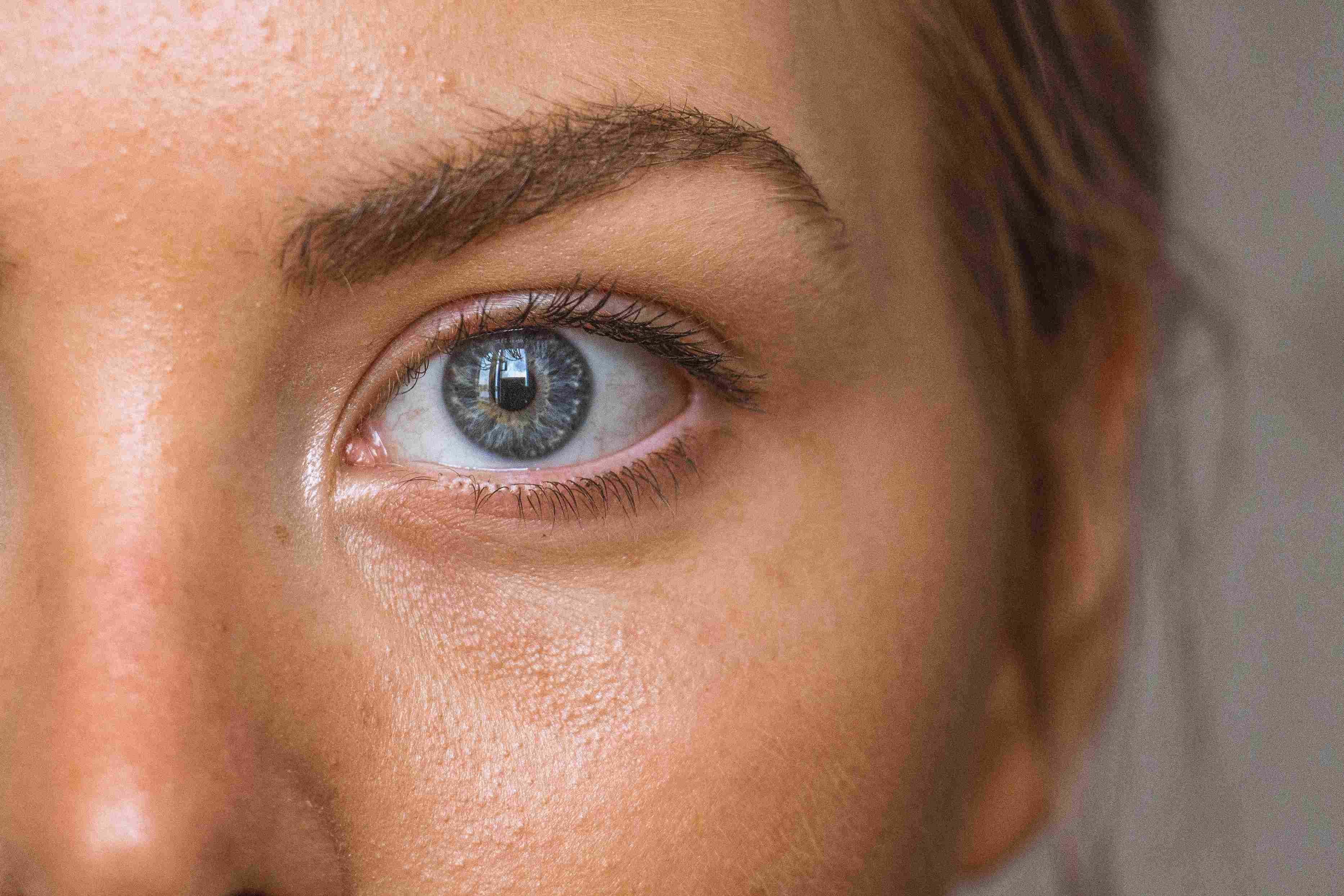
Stages of AMD
Early dry AMD causes no symptoms.
Some people with intermediate dry AMD still have no symptoms. Others may experience mild symptoms such as mild blurriness in their central vision or difficulty seeing in low light.
Many people who have late AMD (both wet and dry type) have noticed that straight lines become wavy or crooked. People may also notice a blurry area near the center of their vision. This blurry vision may worsen over time, and people may notice blank spots.
Treatment for AMD
There is currently no treatment that can help AMD in its early stages. Individuals with a lot of drusen or severe vision loss, on the other hand, may benefit from a specific combination of nutritional supplements based on the National Eye Institute's (NEI) AREDS and AREDS 2 eye surveys (Age-Related Eye Disease Studies). Vitamins like C and E, as well as lutein and zeaxanthin, zinc, and copper.
Aside from that, the eye doctor will usually schedule follow-up appointments to monitor/track how the eyes are doing with regular eye exams. Consuming healthy foods, getting regular exercise, and quit smoking can all help prevent and improve eye problems.
In the advanced stages of AMD, an eye doctor will consult with individuals about the necessary treatment to slow the progression of the eye problem.
References
1. National Eye Institute (NEI). Age related macular degeneration (AMD). https://www.nei.nih.gov/learn-about-eye-health/eye-conditions-and-diseases/age-related-macular-degeneration (Retrieved on January 5, 2023).
2. American Academy of Ophtalmology (AAO). What is macular degeneration? https://www.aao.org/eye-health/diseases/amd-macular-degeneration (Retrieved on January 5, 2023).
3. National Health Services (NHS, UK). What is AMD? https://www.nhs.uk/conditions/age-related-macular-degeneration-amd/ (Retrieved on January 5, 2023).
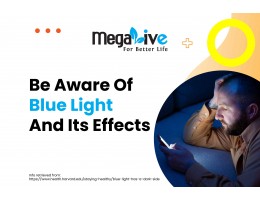
Be aware of blue light and its effects.
Sunlight constitutes of red, orange, yellow, blue, indigo, and violet. When these colours combine, they form the white light that we see. Each of these colours has a different wavelength and energy level, with blue having a shorter wavelength and more energy and red having a longer wavelength and less energy. Light that appears white may contain more blue wavelengths. Sunlight is the most abundant source of blue light. Fluorescent lighting, LED lighting, flat-screen LED televisions, computer monitors, smart phones, and tablet screens are among the others.

Almost all visible blue light is absorbed by the cornea and lens before reaching the retina. This light could impair vision and prematurely age the eyes. According to preliminary research, excessive blue light exposure may cause (1) digital eyestrain (2) retinal damage.
At night, blue light, which appears to be beneficial during the day, appears to be the most disruptive. Blue light is beneficial during the day because it can improve attention, reaction times, and mood; however, with the proliferation of electronics with screens and energy efficient lighting, humans are constantly exposed to blue wavelength, particularly after sundown.

According to research, exposure to blue wavelengths after sundown affects the body's circadian rhythm, increase risk of diabetes, heart disease, and obesity.
A Harvard study found a possible link between light after sundown, the body's circadian rhythm, diabetes, and obesity. The researchers put ten people on a schedule that gradually shifted their circadian rhythm timing. Their blood sugar levels increase, putting them at risk of diabetes, and their leptin levels increase as well (a hormone that promotes feeling full after a meal, went down).
Another blue light study compared the effects of 6.5 hours of blue light exposure to exposure to green light of comparable brightness. Blue light suppressed melatonin about twice as much as green light during the same exposure period, which shifted circadian rhythms by twice as much (3 hours vs. 1.5 hours).
In conclusion, blue light after sundown can affect health in a variety of ways. While we need this to progress in this modern society, we can also make minor adjustments to make things work without jeopardizing health.
- For night lights, use dim red lights because red light is less likely to disrupt the circadian rhythm and suppress melatonin.
- Avoid looking at bright screens beginning two or three hours before sleep.
- Consider wearing blue-blocking glasses at night if you work a night shift or use a lot of electronic devices.
- Allow yourself to be exposed to a lot of bright light during the day, which will improve your ability to sleep at night as well as your mood and alertness during the day.
References
- Blue light has a dark side. Harvard Health. https://www.health.harvard.edu/staying-healthy/blue-light-has-a-dark-side (Retrieved on January 3, 2023).
- Seeing blue: How can blue light affect your health. WebMD. https://www.webmd.com/eye-health/blue-light-health (Retrieved on January 3, 2023).
- What is blue light. Prevent blindness. https://preventblindness.org/blue-light-and-your-eyes/ (Retrieved on January 3, 2023).
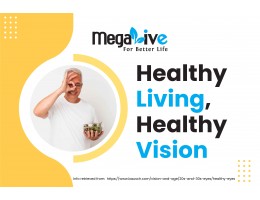
Healthy Living, Healthy Vision.
Eat Healthy Food
It is commonly assumed that the health of your eyes is unrelated to what you consume, but the truth is that it is. Consuming nutrient-dense foods will allow you to maintain good health, thereby avoiding complications that may arise in your eyes as a result of your health complications.
As part of a healthy diet, choose foods high in antioxidants, such as vitamins A and C, which have been shown to benefit eye health. Foods high in vitamins A and C include green leafy vegetables and foods with bright colours like orange and red. It also contains carotenoid, which is beneficial to the eyes. Carotenoid is an antioxidant found in plants that are brightly coloured, such as red, orange, yellow, and green. Aside from that, it can act as a cancer-fighting agent. Carotenoid works in the macular (the most sensitive part of the retina responsible for vision production and colour perception).
Lutein and zeaxhantin are types of carotenoids.

Inadequate antioxidant intake, alcohol consumption, or saturated fat consumption may result in free-radical reactions that harm the macula. High-fat diets can also cause deposits in the arteries that restrict blood flow. Because of the small size of the blood vessels that feed the eyes, they are especially sensitive to this.
Exercise regularly
By exercise regularly, body will have lower risk of getting various kind of metabolic disease such as diabetes, kidney problem and heart problem, thus lower the risk of getting complication that can impair eyes function. Example of metabolic disease that can impair eyes directly is, diabetes, which in the later stage can cause diabetic retinopathy. The condition where blood vessels of the light-sensitive tissue at the back of the eye (retina) is damaged. At first, it may cause no symptoms or mild blurry vision, eventually it can cause blindness.

Wear sunglasses
The American Academy of Opthalmology (AAO) encourages people to protect their eyes from the sun's harmful UV rays. Sunglasses are more than just a fashion statement; they are also a wise and healthy choice. Long-term sun exposure without adequate protection can increase the risk of eye disease such as cataract, macular degeneration, eye growth, and a rare form of eye cancer.
While short-term exposure can also damage the eyes. Sun reflecting off water can cause a painful sunburn on the front part of the eye, called photokeratitis. It causes redness, blurry vision, sensitivity to bright light, and in rare cases, even temporary vision loss.
The good news is that prevention is simple: Wear sunglasses that block 99 to 100 percent of both UVA and UVB radiation.
Quit smoking
Smoking is not only bad for your lungs. It can hurt your eyes, as well. Smoking increases your risk of eye diseases like macular degeneration and cataracts.
Eye care in conclusion
People usually take their eyesight and health for granted; it was only when we began to lose the ability that we began to take it seriously. Start taking care of your eyes now by doing the above. If you are constantly looking at a screen, you can also give your eyes a break every 20 minutes by looking 20 feet away for 20 seconds. If you have a family history of eye problems, schedule a comprehensive dilate eye exam on a regular basis. If you wear contact lenses, make sure to disinfect them and replace them on a regular basis. Also, remember to wash your hands before touching your eyes or face
References
- National Institute of Health (NIH). National Eye Institute (NEI) (July 2020). Keep your eyes healthy. https://www.nei.nih.gov/learn-about-eye-health/healthy-vision/keep-your-eyes-healthy (Accessed on July 28, 2020).
- Bausch + Lomb. Healthy Eyes. https://www.bausch.com/vision-and-age/20s-and-30s-eyes/healthy-eyes (Accessed on July 28, 2020)
- All About Vision. How carotenoid can keep your eyes healthy. https://www.allaboutvision.com/nutrition/carotenoids.htm#:~:text=According%20to%20nutrition%20research%2C%20an,macular%20degeneration%20later%20in%20life. (Accessed on July 28, 2020).
- Mayo Clinic. Diabetic Retinopathy. https://www.mayoclinic.org/diseases-conditions/diabetic-retinopathy/symptoms-causes/syc-20371611#:~:text=Diabetic%20retinopathy%20(die%2Duh%2D,or%20only%20mild%20vision%20problems. (Accessed on July 28, 2020)
- American Academy of Opthalmology. Sunglasses your prescription for eye health. https://www.aao.org/newsroom/news-releases/detail/sunglasses-your-prescription-eye-health (Accessed on July 28, 2020).
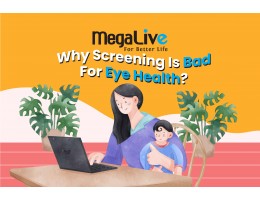
Why screening is bad for eye health ?

In this fast-changing world that we are in today, people want things to be done quick and always ready! People use various kind of devices and gadgets to speed up process of doing work. Initially, computer was built not for the sake of email and doing work, but it is actually to calculate and tabulate census for United States of America population since the population has grown bigger, it was started with a machine sort of punch card machine in 1880, where due to this the government save about $5 million in order to tabulate the census. From that sort of punch card machine, Alan Turing then presents another universal machine which capable of computing anything that is computable, the central concept of modern computer today is based on his ideas. Few years later, in 1939 Hewlet – Packard is founded by David Packard and Bill Hewlett in California, until today the computer that we are using is evolve from time to time, to the small smartphone on our hands that is capable of doing so many thing just like the bulky desktop (1).

All these technologies make us even more connected to devices like smartphone to connect with other people or to get things done. From paying bills, to designing, networking, sales, work, presentation, you name it all must be done using laptop, computer, smart phone, and the devices. The fact is everyone everyday is looking at the screen for long time, when the recommended hour to look at the screen is only 2 hours per day (2).
Why screening is bad for eyes?
White light that we see from sun and electronic devices is a combination from red, orange, yellow, green, blue, indigo, and violet light. Each of these lights has different energy and wavelength. Rays on red have longer wavelength and less energy, while the blue rays have shorter wavelength and more energy. Light that looks white can have a large blue component, which can expose the eye to a higher amount of wavelength from the blue end spectrum (3).
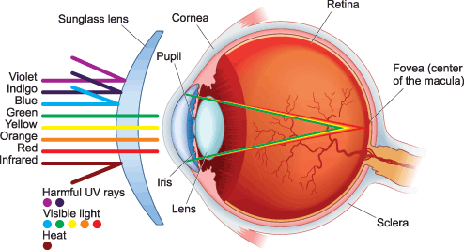
Sun also have this blue light, but blue light exposure from screen is small compared to exposure from sun, thus why makes it bad for eyes. Furthermore, screen exposure has closer proximity to eyes and the time spent looking at screen is longer than at the sun (3,4).
Almost all visible blue light penetrates the eyes through cornea, lens and reaches the retina, due to this, it makes eyes prematurely aging.
Blue light from computer screens and digital devices can decrease contrast leading to digital eyestrain. Fatigue, dry eyes, bad lighting, or how you sit in front of the computer can cause eyestrain. Symptoms of eyestrain include sore or irritated eyes and difficulty focusing. Apart from that, studies also suggested that continued exposure to blue light over time could lead to damaged retina cells. This condition can cause problems like age-related macular degeneration (4).
Macular degeneration is the result of photoreceptor cell death in the retina. The function of the photoreceptor cells is to capture visual images and signal them to the brain using a molecule called retinal. Retinal, which is produced by the eye, is triggered by blue light and causes various chemical reactions. These reactions within the eye can be poisonous to the photoreceptor cell molecules rendering them damaged. When these photoreceptor cells die, there’s no regeneration (4).

What can we do?
With the current work requirements where most of work and stuff need to be accomplished through the usage of electronic devices thus screening is very much essential, makes it even harder to take care eyes from the screen. No! There are actually ways to take care of your eyes still, apart from consume food that is high with antioxidants and vitamins that can improve eyesight condition you may also try and practice the tips below (5)!

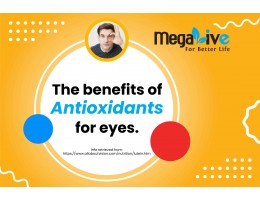
The benefits of antioxidants for eyes.
As humans, we never truly appreciate our senses until we lose them. One of the many things we should be thankful for is our senses of smell, touch, sound, taste, and sight. Isn't it horrible to wake up one day and not be able to see, touch, hear sound, or smell?
Many people take their sense of sight for granted because they believe that vision problems can be corrected with the help of lenses or spectacles. People even take it lightly now that we have advanced technology, such as Lasik surgery, because they believe there is a cure. When, in fact, there are numerous health complications or conditions that can impair your ability to see, such as being diagnosed with diabetes. Isn't it terrifying?
The good news is that nutrition can prevent this from happening! A varied and balanced diet can help to prevent many diseases, including blindness. Many studies have found that consuming antioxidants, also known as cancer fighting agents, can help prevent vision loss. Antioxidants are compounds that aid in the scavenging of free radicals that can cause cell mutation and cancer.
Since many of these antioxidants are found in plant-based diets such as vegetables and fruits, one mechanism for this is said to be due to the prevention of other chronic diseases such as hypertension and diabetes, lowering the risk of vision loss. Lutein and zeaxanthin, vitamin A, omega 3, and vitamin C are all antioxidants that have been linked to vision health (2).
Lutein and zeaxanthin are members of the carotenoid family, which is a well-known antioxidant for eye health. Apart from being found in green leafy vegetables like spinach, it can also be found in yellowish, orange-red plant-based foods like capsicum. In nature, lutein and zeaxanthin appear to absorb excess light energy to protect plants from overexposure to sunlight, particularly high-energy light rays known as blue light. While in the human body, lutein and zeaxanthin are abundant in the macula of the human eye, the name 'macula lutea' is derived from lutein, which means yellow spot.

The National Eyes Institute (NEI) conducted research on lutein, zeaxanthin, and the effect of carotenoids supplement taking in May 2013. It is the second largest eye- disease research study, namely, AREDS2. The purpose of this study was to see how nutrients, such as lutein and zeaxanthin, affected the prevention of AMD and other age-related eye diseases. For five years, participants in this study were given 10 mg of lutein and 2 mg of zeaxanthin every day. The use of daily antioxidant supplementation reduces the risk of progressive Age-related-Macular Degeneration (AMD) by 25% among those with early and intermediate macular degeneration, according to this study. However, it is unclear whether it can aid in the prevention of cataracts and their complications.
Vitamin A is another common antioxidant for the eyes. Night blindness is commonly caused by a lack of vitamin A. Vitamin A functions as photoreceptors, where it aids in the maintenance of light-sensing cells in the eyes. It's found in animal-based foods like dairy and egg yolk.
Omega 3 Fatty Acids (1,2)
EPA and DHA, which are derived from omega-3 fatty acids, are essential not only for brain development during infancy, but also for vision health. A study of people with dry eyes found that taking EPA and DHA supplements daily for three months significantly reduced dry eye symptoms by increasing tear fluid production (lacrimal fluid). Oily fish is a good source of EPA and DHA, and microalgae supplements are also available.

Vitamin E (1,3)
Vitamin E is a fat-soluble vitamin that protects fatty acids from oxidation. Because the retina contains a high concentration of fatty acids, adequate vitamin E intake is essential for good eye health. A study that supplemented 7 mg of vitamins E found that it can reduce the risk of age-related cataracts by 6%. However, a randomized controlled study discovered that vitamin E supplementation does not slow or prevent the progression of people who already have eye problems. Almonds, sunflower seeds, and flaxseed oil are good sources of vitamin E.
Vitamin C (1,3)
Vitamin C is commonly consumed for skin purposes, but since many studies have discovered that vitamin C is an important antioxidant for eye health as well, many supplements are now beginning to incorporate vitamin c rich sources in eye supplementation. It's a good thing because it gives you two effects in one!
Zinc (1,3)
Zinc is abundant in the eyes. It functions as a transporter for vitamin A, which is later involved in the formation of visual pigments in the retina known as melanin. As a result, zinc deficiency has been linked to night blindness. Oysters are a natural dietary resource high in zinc that is also beneficial to men's health!
In conclusion
Taking care of your vision health entails more than just avoiding screens and wearing sunglasses when you go outside. It is also what you put inside your body. Again, healthy eating is important for overall health, including vision!
References
-
All About Vision. Lutein and Zeaxanthin. Eye and vision benefits. https://www.allaboutvision.com/nutrition/lutein.htm (Accessed on Aug, 26, 2020).American
-
Optometric Association (AOA). Diet and Nutrition. Adding Powerful Antioxidants in your diet. https://www.aoa.org/healthy-eyes/caring-for-your-eyes/diet-and-nutrition?sso=y (Accessed on Aug, 26, 2020)
-
8 Nutrients that will optimize your eye health. https://www.healthline.com/nutrition/8-nutrients-for-eyes. (Accessed on Aug 26, 2020)




